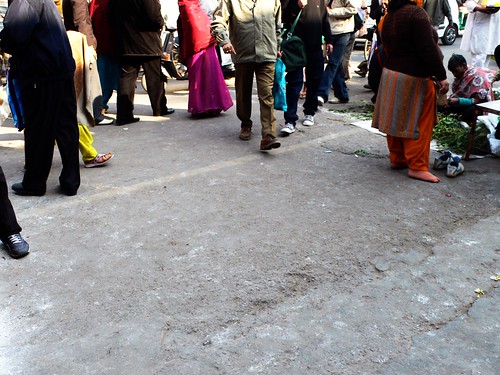
Motor vehicles often impede on pedestrian space in New Delhi, India. Photo by kandyjaxx.
Thirty-three percent of commuters in Delhi, India walk to work in conditions that could be described as hazardous to your health. A report published by the Centre for Science and the Environment notes that nearly every pedestrian space in the city, with the exception of the Delhi bus corridor, which has dedicated cycling and pedestrian infrastructure, is vulnerable to motorized vehicle traffic.
It shouldn’t be surprising to learn that pedestrians account for 47% of traffic fatalities in the city. CSE notes that a focus on building roads where cars can sail smoothly without stopping at lights has come at the expense of pedestrians who find it difficult and dangerous to cross streets in heavy traffic. The investment in more and more space for cars, it would seem, has also channeled funding away from projects that could improve conditions for pedestrians.
CSE makes a call for action with several concrete steps for improving pedestrian spaces:
- Government should mandate pedestrian plans and make it conditional to infrastructure funding: Investments in road infrastructure before Commonwealth Games must be linked to an explicit pedestrian plan in Delhi. Even in other cities city development plans under JNNURM programme should have mandatory provision of pedestrianisation and the funding should be linked with it.
- Immediately reform engineering and environmental guidelines for walkways and make their implementation mandatory: Ensure these guidelines are incorporated by all road building agencies.
- Harmonise existing laws for effective implementation: While relevant laws will have to be harmonised it will have to be combined with more direct legal protection of pedestrian space and rights.
- Need a comprehensive road users act for targeted pedestrianisation; segregation of space by users; system of penalty to prevent encroachment in pedestrian space; prevent usurpation of pedestrian space for motorised traffic without proper justification.
- Urban local bodies must implement walkability audits of pedestrian ways
- Public transport plans must include pedestrian plan for multimodal integration.
- Zero tolerance policy for accidents
- Mandate pedestrian plans in small and medium towns: The programme for small and medium towns under the aegis of the Union ministry of urban development should make pedestrian plan mandatory.





